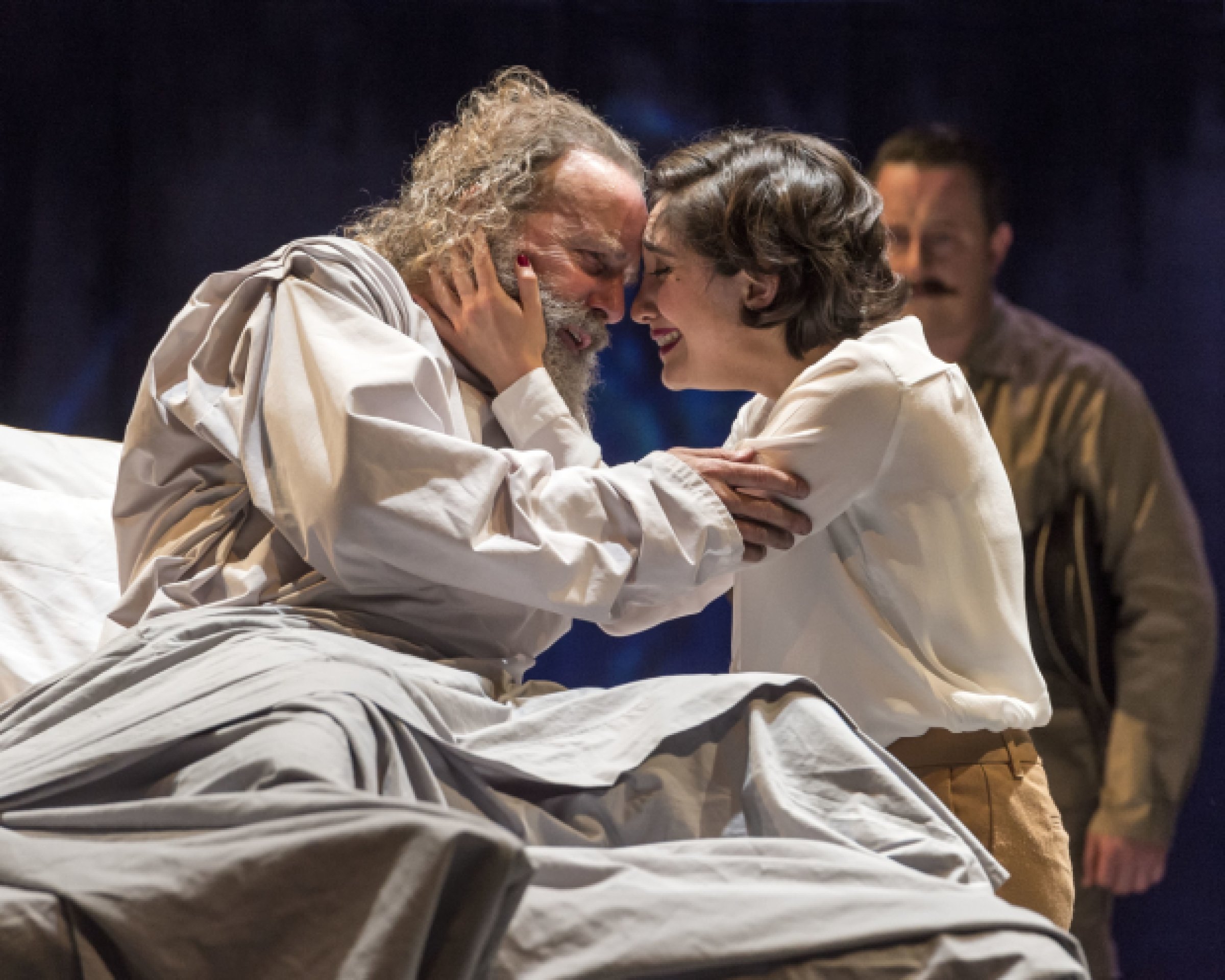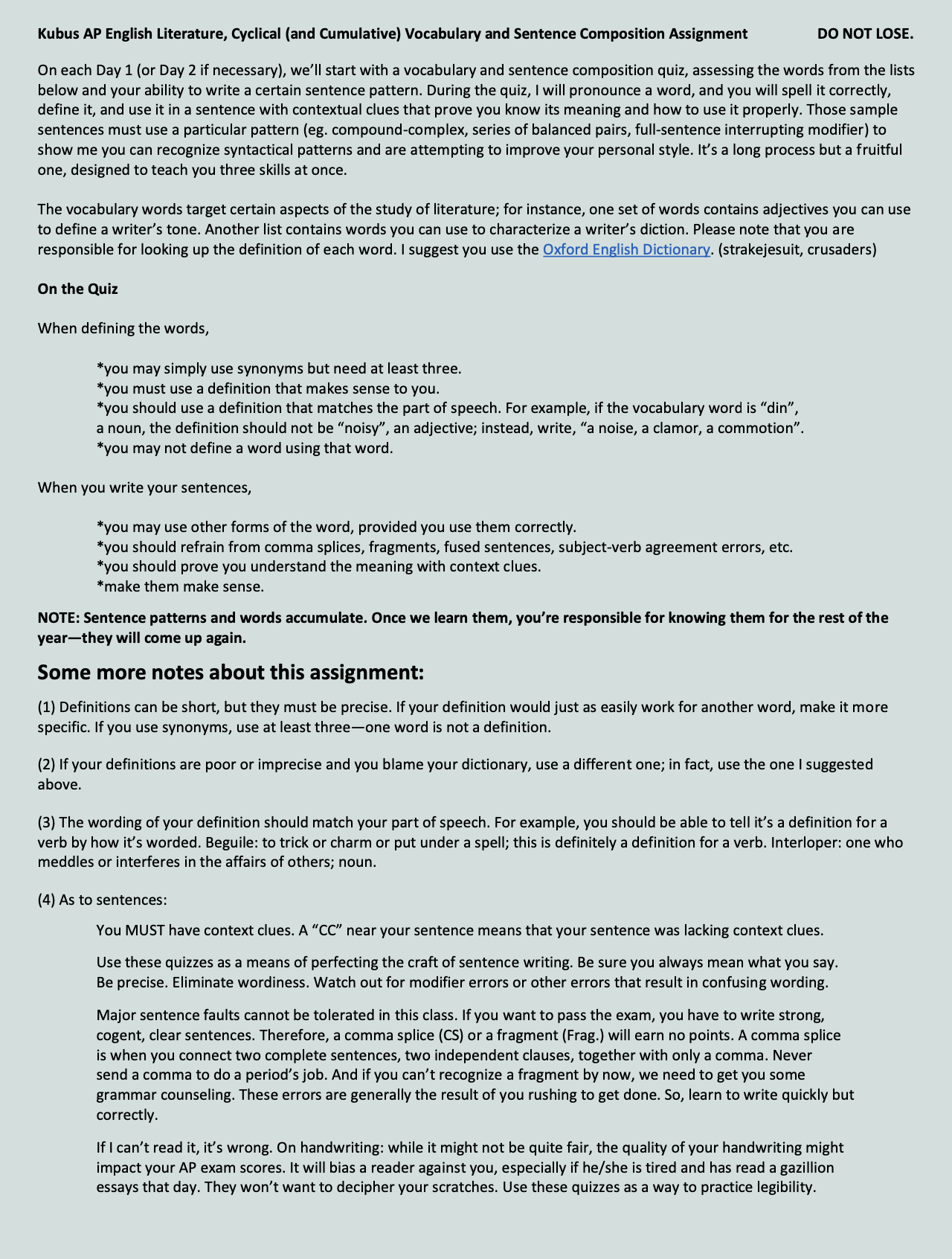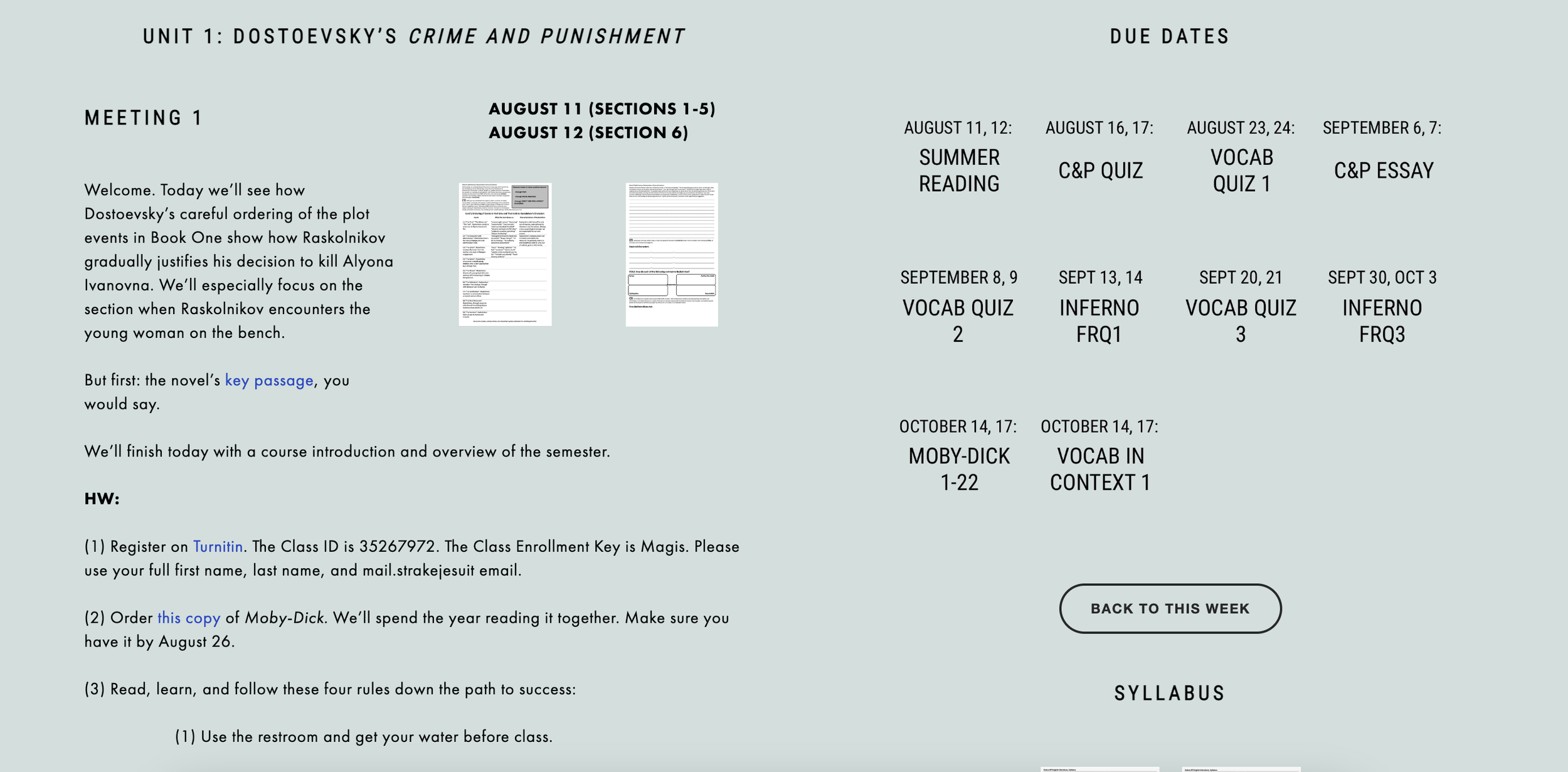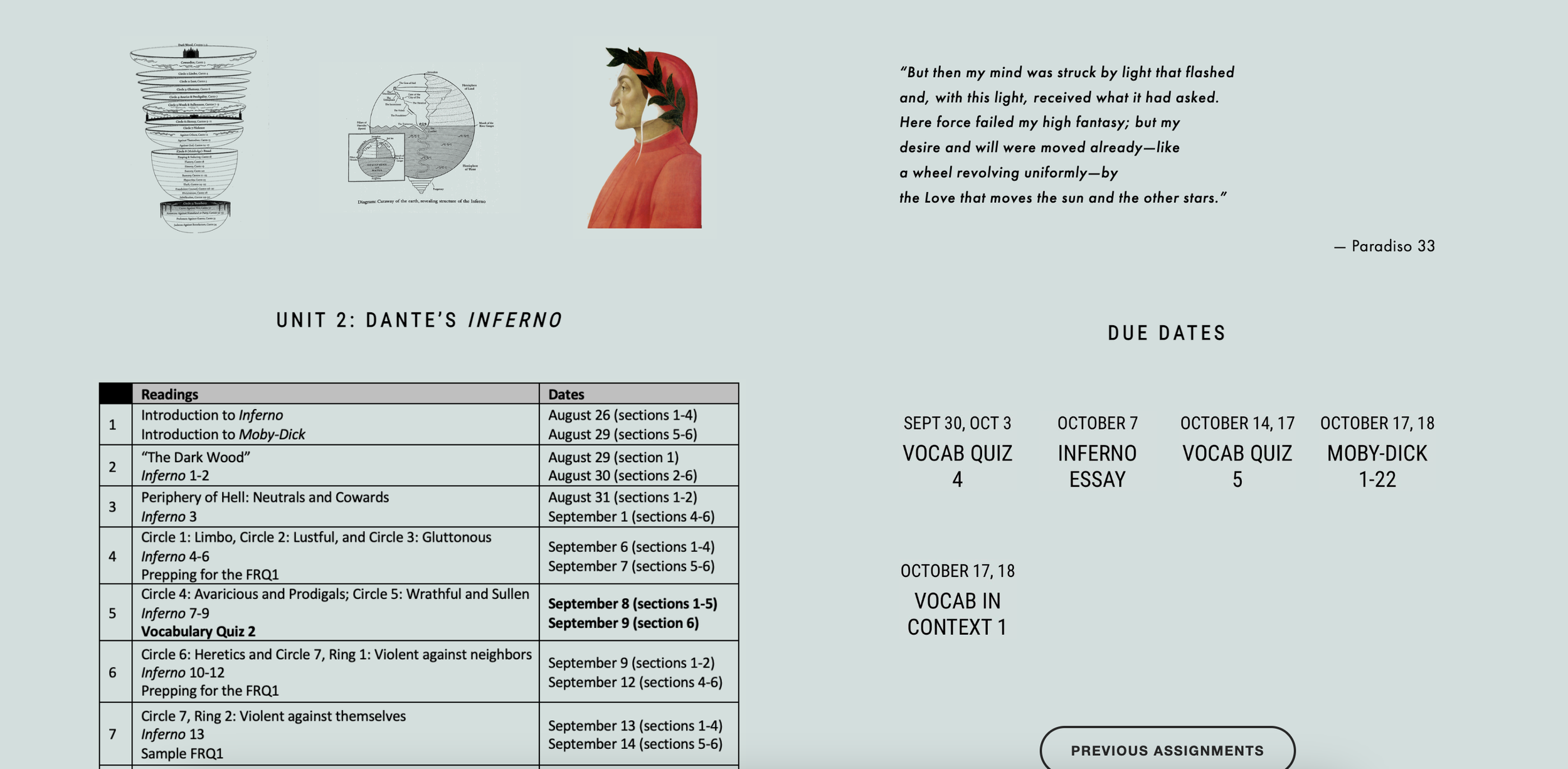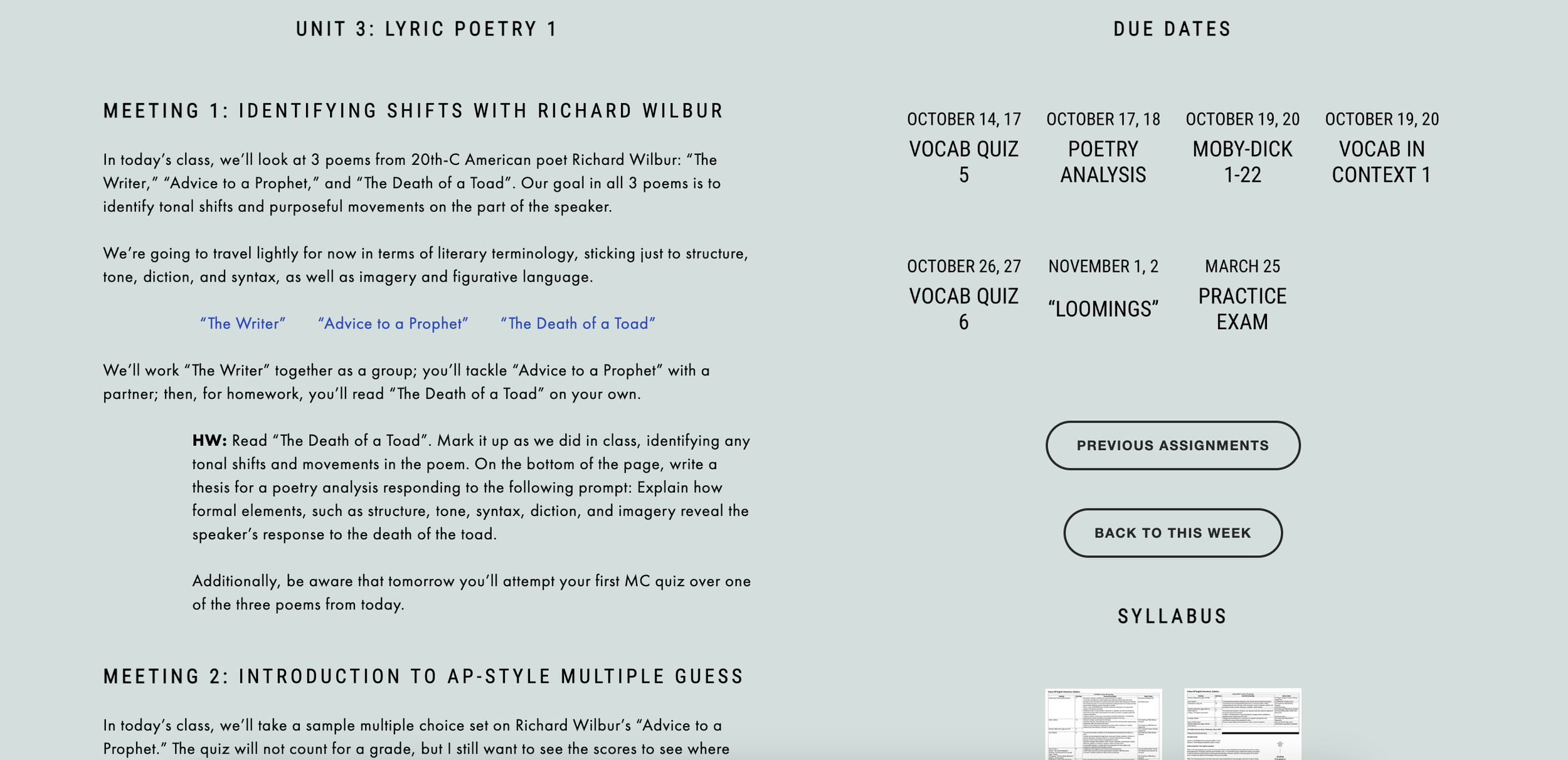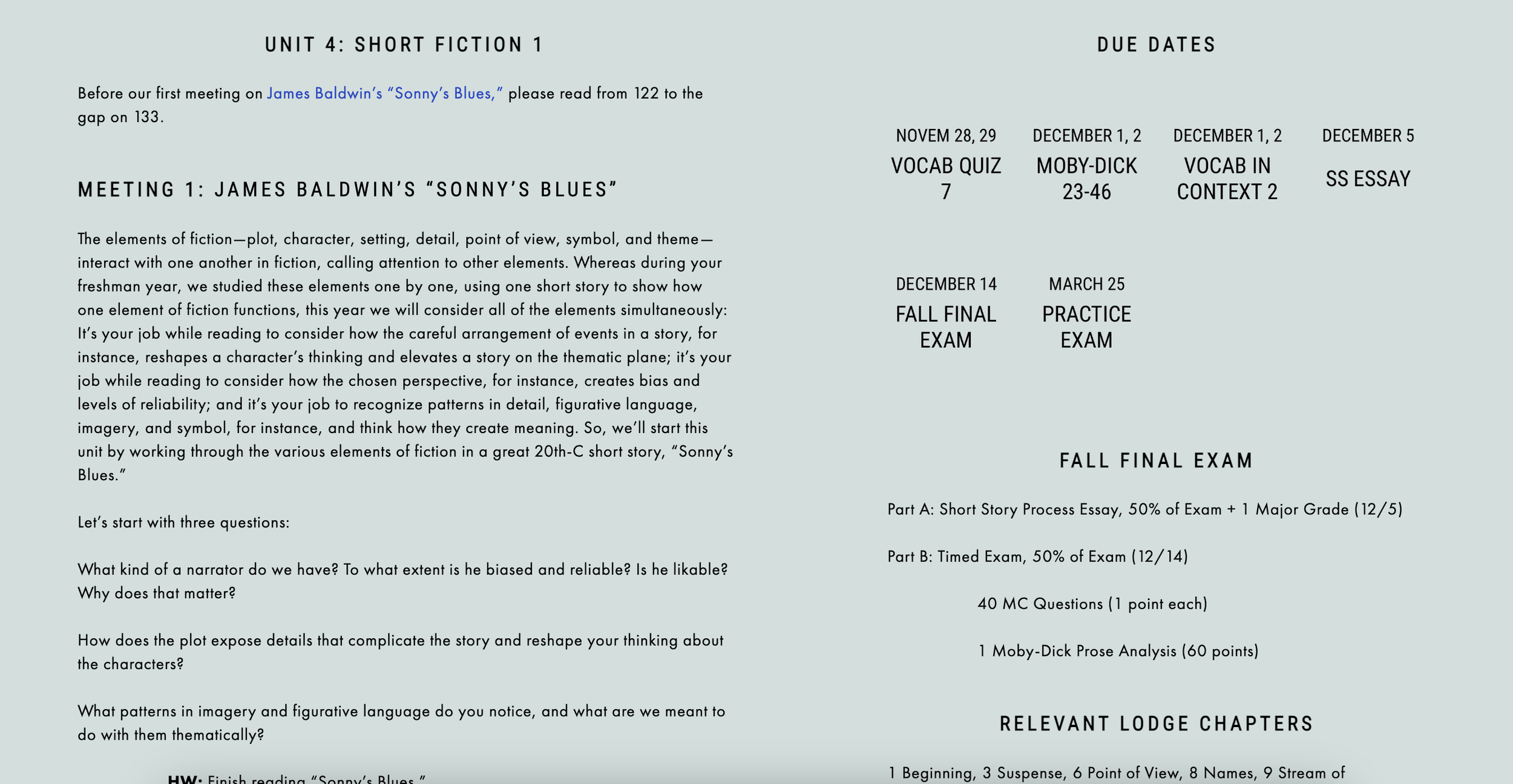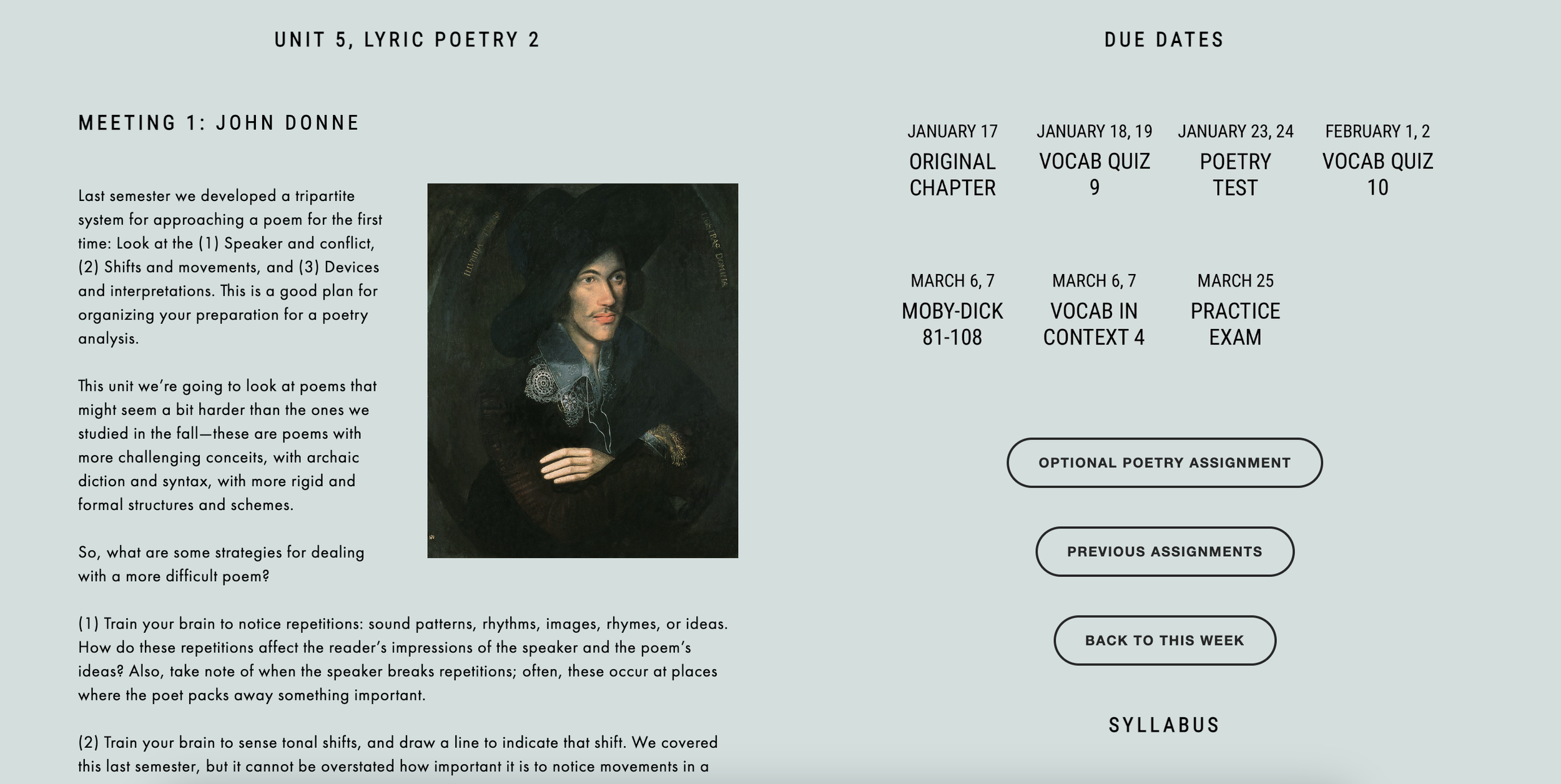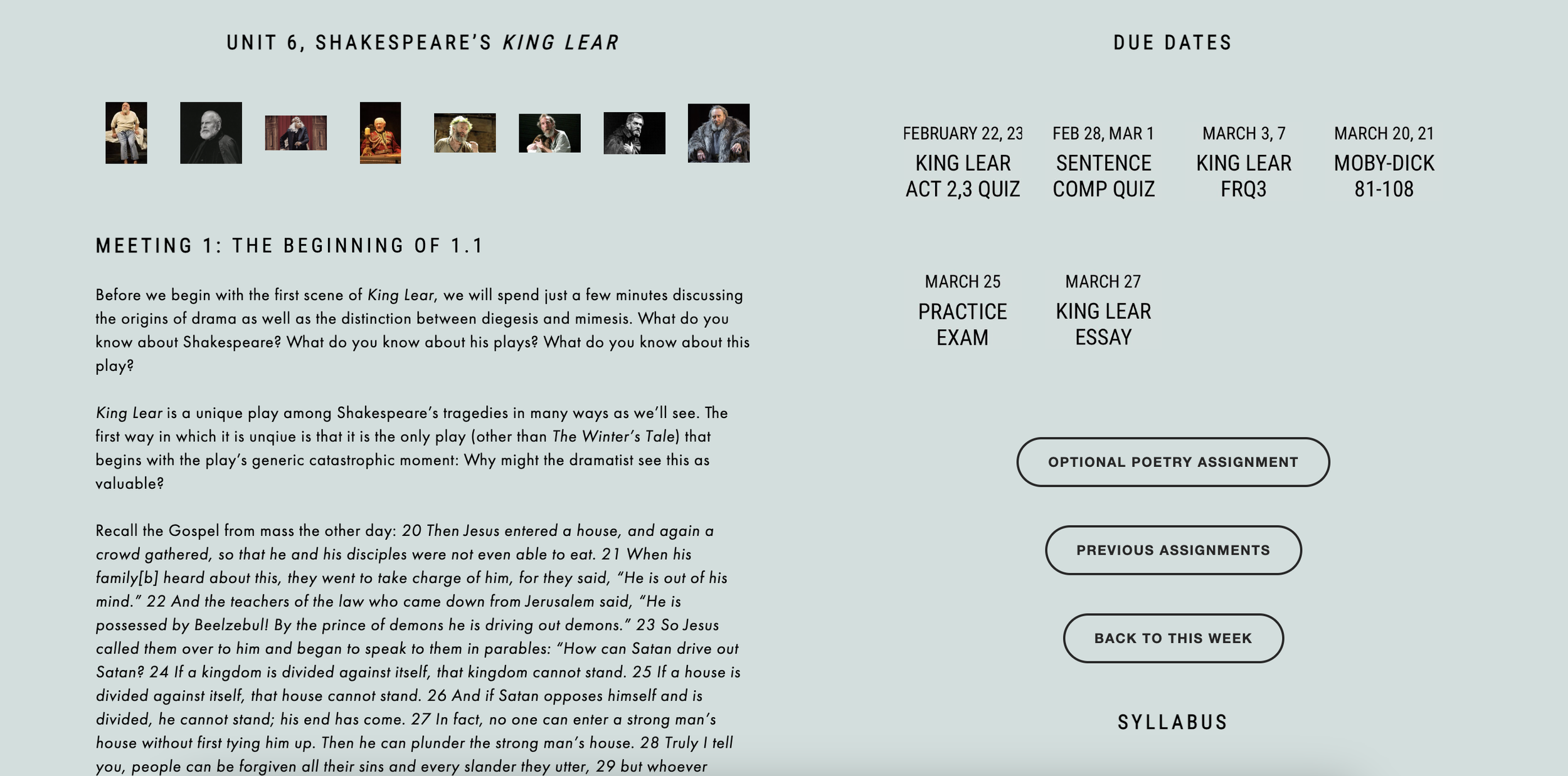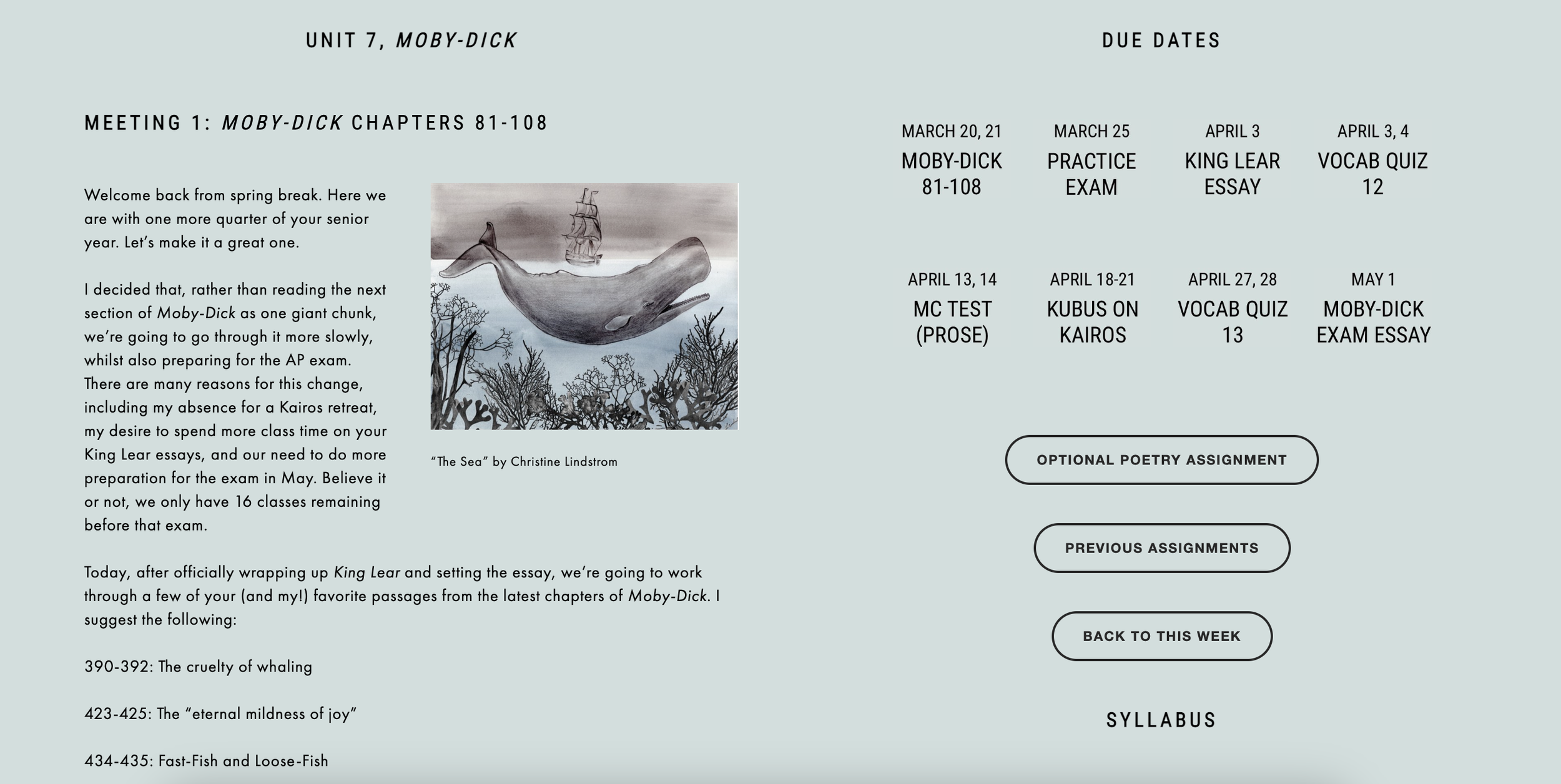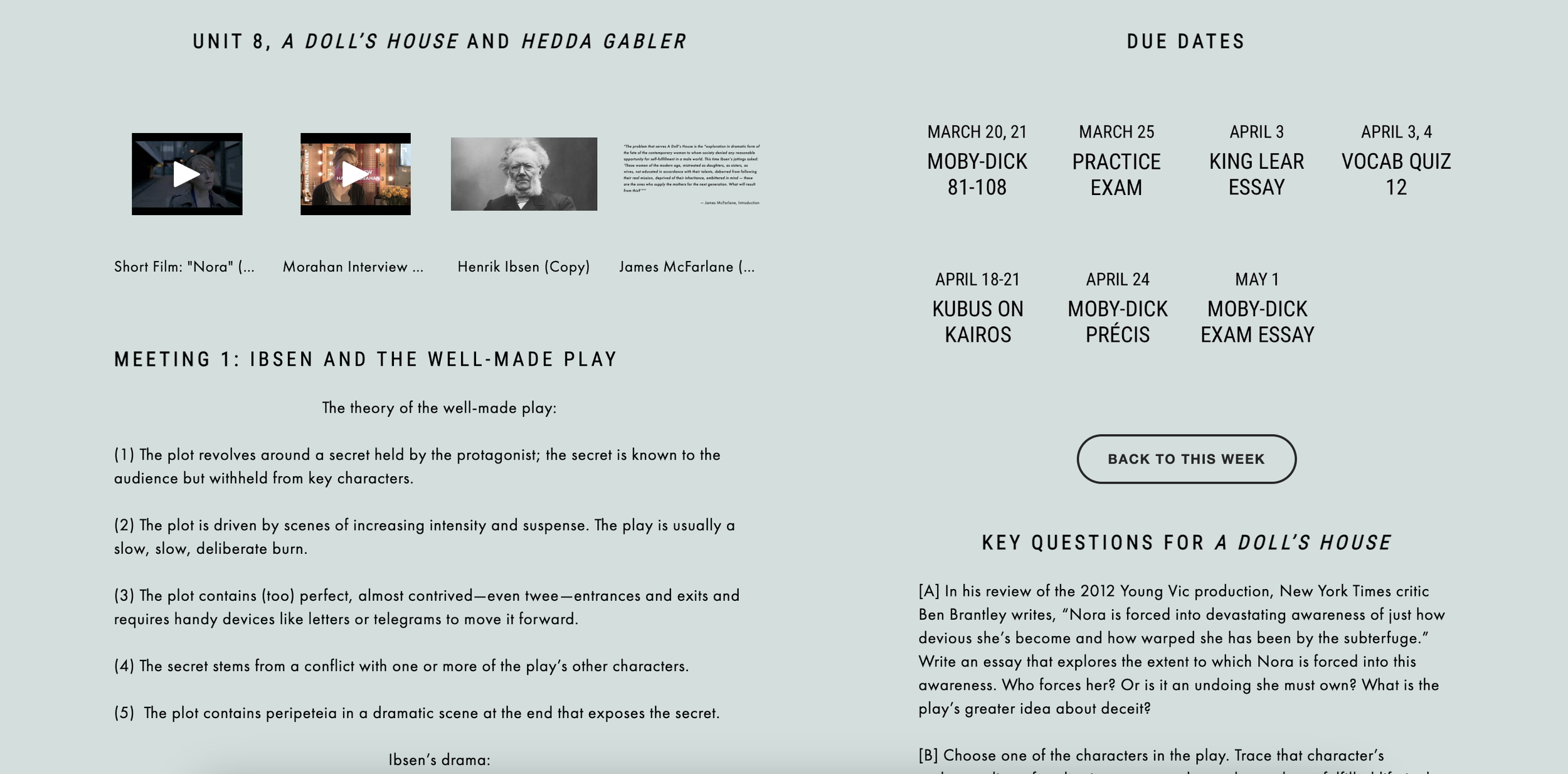unit 4: king lear
MEETING 1: the beginning of king lear
King Lear is a unique play among Shakespeare’s tragedies in many ways as we’ll see. The first way in which it is unique is that it is the only play (other than The Winter’s Tale) that begins with the play’s generic catastrophic moment: Why might the dramatist see this as valuable?
Cardinal DiNardo asked us to read the Gospel of Mark last Lent. Here’s a short passage: 20 Then Jesus entered a house, and again a crowd gathered, so that he and his disciples were not even able to eat. 21 When his family[b] heard about this, they went to take charge of him, for they said, “He is out of his mind.” 22 And the teachers of the law who came down from Jerusalem said, “He is possessed by Beelzebul! By the prince of demons he is driving out demons.” 23 So Jesus called them over to him and began to speak to them in parables: “How can Satan drive out Satan? 24 If a kingdom is divided against itself, that kingdom cannot stand. 25 If a house is divided against itself, that house cannot stand. 26 And if Satan opposes himself and is divided, he cannot stand; his end has come. 27 In fact, no one can enter a strong man’s house without first tying him up. Then he can plunder the strong man’s house. 28 Truly I tell you, people can be forgiven all their sins and every slander they utter, 29 but whoever blasphemes against the Holy Spirit will never be forgiven; they are guilty of an eternal sin.”
Each great scene in a play will revolve around a central conflict. The central conflict in 1.1 is Lear’s desire to give up power but inability to give up all of the things that come with power.
Homework: Finish your essay.
MEETING 2: comedy/tragedy & 1.1-1.3
Mosaic depicting theatrical masks of Tragedy and Comedy, 2nd century AD, from Rome, Palazzo Nuovo
Today we’ll discuss Shakespeare’s genres. Comedy and tragedy don’t merely delineate happy and sad; more precisely, comedy and tragedy refer to the narrative structure of a play, the way in which the play’s dramatic conflicts resolve. A Midsummer Night’s Dream and Romeo and Juliet are largely the same play, but one is a comedy and one is a tragedy because of the way the conflicts resolve: If Juliet wakes 30 seconds earlier, the play is a comedy; if the lovers don’t discover they’ve been in love with the wrong person, they just might die. Comedies end happily in marriage; tragedies end unfortunately in death. Shakespeare, however, knows that good drama blurs of the lines of these genre and uses elements of each in many of his plays.
Why is Lear so cruel to Cordelia in the second half of 1.1? Is he being petulant by throwing the word “nothing” back at Cordelia, or is it coincidence?
What does Cordelia have to say about flattery and lying in her speech on page 15? And what of her prophetic line to her sisters: “Time shall unfold what plighted cunning hides;/Who covers fault, at last with shame derides”?
Homework:
I’d like you to try your hand at finishing the next scene, Act 1 scenes 2 and 3. Prepare them for our next class. While reading, think about how Edmond and Edgar’s dialogue compares to Gonerill and Regan’s dialogue in the previous scene. If you want also to watch the Royal Shakespeare Company production, you may log in to Drama Online Library with strakejesuit, crusaders. It will help to watch the scene. It begins at 18:45.
MEETING 3: SHAKESPEARE’S FOOLS & 1.2-1.5
1.2: What parallels do you see between 1.1 and 1.2? How does Edmond manipulate his father so quickly? Is it believable that he might be convinced so quickly?
1.4: We’ll talk today about the convention of the Fool in Shakespeare’s plays with particular focus on the license they have to criticize the behavior of those they serve. In his first scene the Fool makes about 25 jokes, many of them puns, all of them intended to show Lear’s mistakes. There seem to be 4 subcategories of criticism:
1) It was stupid to give up power and wealth. 2) It was really counterproductive to have banished Cordelia. 3) It was dumb to put yourself at the mercy of your evil daughters. 4) It was all caused by the fact that you act without thinking.
What’s the difference between the loyalty of the Fool and the loyalty of Kent?
1.5: How have your sympathies for Lear changed, if at all, by the end of the Act?
Homework:
Read Act 2, scenes 1 and 2 before our next class. You will have a quiz on the play through 2.2.
MEETING 4: soliloquy, the bedlam beggar, & 2.3
Soliloquy literally means talking alone, and it has been used as a form since the Greeks, though popularized by Shakespeare and his contemporary playwrights. In the theater, no thinking can be made directly available to the audience unless it is brought to speech, so it was necessary to propose a convention: the character would speak aloud, and the audience would understand that what they were to imagine they were hearing was what the character was saying to himself, or what he would say if he were to give voice to his thought.
Real drama occurs when characters keep things from each other. The ONLY time, in fact, that an audience should accept that what characters are saying is absolutely true is when a character is in soliloquy. In all other instances there’s the possibility of deceit. So, it’s the responsibility of the playwright in a soliloquy to communicate what is absolutely true. Edmond, for instance, is completely forthcoming about his intentions to prove a villain.
2.1, 2.2: What’s your reaction to Edgar? How might we explain his quick departure?
How does Edmond incorporate Cornwall’s arrival as well as the growing divide between him and his brother-in-law?
What’s your favorite Kentian insult?
Examine 2.2.63-75: Why, according to Kent, is Oswald the worst kind of person?
2.3: First, I’ll set the context for Edgar’s means of hiding: What is a bedlam beggar? What strikes you about the first of Edgar’s many soliloquies?
MEETING 5: machiavelli & my favorite scene, 2.4
“Everyone sees what you appear to be, few experience what you really are.”
“If an injury has to be done to a man it should be so severe that his vengeance need not be feared.”
“The lion cannot protect himself from traps, and the fox cannot defend himself from wolves. One must therefore be a fox to recognize traps, and a lion to frighten wolves.”
“The first method for estimating the intelligence of a ruler is to look at the men he has around him.”
“There is no other way to guard yourself against flattery than by making men understand that telling you the truth will not offend you.”
“Never attempt to win by force what can be won by deception.”
“It is much safer to be feared than loved because ... love is preserved by the link of obligation which, owing to the baseness of men, is broken at every opportunity for their advantage; but fear preserves you by a dread of punishment which never fails.”
Pick a quote from “The Prince”, above, and a character from King Lear who might respond to that quote. How might that character respond?
2.4.1-117: 2.4 is in my top 10 scenes from Shakespeare’s plays. It’s an extraordinarily sad descent into madness. Let’s read the first half before pausing to think it through.
2.4.118-end: We need to decipher whether Lear himself is or Gonerill and Regan are to blame for his descent. Does Lear make things worse for himself? Why is there a storm in the background?
Homework: Read through the end of 3.3.
MEETINGs 6/7: shakespeare’s favorite question; 3.1-3.3
A total of twenty scenes throughout all of Shakespeare’s plays begin with a line I’ve dubbed Shakespeare’s favorite question: “Who’s there?”. Hamlet begins with it; Othello ends with three instances of it; Macbeth’s Porter asks it three times in one speech; in the following scenes in King Lear, characters ask it several times. In forty plays, it appears fifty times. And while you might say—‘Well, of course, Mr. Kubus. “Who’s there?” is a common question and a practical one in a staged drama. Why wouldn’t it appear that often?’—I’d like to explore both the dramatic and thematic functions of the question in any given play, in this play, and in this scene.
One of Shakespeare’s most famous scenes, 3.2, depicts the pathetic fallacy, weather mirroring Lear’s madness. Why is that particularly appropriate given what many characters argue about nature?
How is the fool different in 3.2 than he was before? What do we learn in this scene about the nature of his foolery?
There are three parts of Lear’s diatribe in 3.2. We’ll move through all three today in class before watching our production’s version of the scene.
Homework:
Finish reading Act 3 for meeting 7. In the remainder of Act 3, Shakespeare begins alternating between Lear and Gloucester, the play’s two old men. What is Shakespeare’s dramatic intent in alternating these scenes as he does? What thematic point might he be trying to highlight? Is there any intelligibility in the way Edgar manifests Tom’s madness?
——
Read through 4.3 by meeting 8.
MEETING 8: recognitions, reunions, miracles
Who is vying for power in Britain at this point in the play? I think it’d be helpful to step back and first consider the various narrative threads and how they’re tangling.
Scenes 5 and 6 of King Lear stand tall above most other scenes in the history of drama not only for their emotional impact but also for the contrast they draw toward one another. Of course they are both scenes of recognition, of knowing again, of becoming reacquainted, but what do you see as the key distinctions between the recognitions of Gloucester/Edgar (even though Gloucester doesn’t quite know entirely who Edgar is), Lear/Gloucester, and Lear/Cordelia? They are also scenes of miracles, of impossible reunions that take shape, or at least that’s how they’re framed in the text. What does Shakespeare want us to see in putting these two scenes right next to each other?
Sift through Lear’s madness. Find
(1) sorrow.
(2) humor.
(3) wisdom through suffering.
What’s the dominant emotion in King Lear when he first sees Cordelia? Is it shame? Is it joy? Why?
HOMEWORK FOR OUR NEXT CLASS:
Read through 5.2. Leave the last scene for us to work through together in our next class.
MEETING 9: Act 5
Samuel Johnson said of the final scene of King Lear that it’s too sad to perform. As we work through the scene, ask yourself why Johnson would’ve made this claim.
Do you think the Lear of Act 5 is too different from the Lear of Act 1? If not, what has it taken to get him from point A to point B?
In 5.3, after Cordelia’s first line, she’s silent for the rest of the play. Of this and the general treatment of Cordelia, scholar Kathleen McLuskie says, “Cordelia’s saving love, so admired by critics, works in the action less as a redemption for womankind than as an example of patriarchy restored.” What do you think? Does McLuskie have a point? Can the same rationale be applied to the poor and disabled—that is, does the fact that the poor lose their voice in the play simply restore the monarchy as it was at the beginning of the play? Do you think Shakespeare is conscious of this?
Kent asks near the very end of the play, “Is this the promised end?” Is it? Did Shakespeare break a contract? Is the sadness to much?
Are you satisfied with the political resolution of the play? Is it appropriate? Why or why not?
due DATES
FALL FINAL EXAM
In-class King Lear Literary Argument Essay, 11/21-11/22
———
15 MC Questions (7 Poetry, 8 Prose), 12/17
Prose Analysis (War and Peace), 12/17
Poetry Analysis (Shakespeare), 12/17
CURRENT TEXT TO HAVE DAILY
king lear: true or false?
(1) Taken out of context, Edgar’s line to his father, “Thy life’s a miracle,” states the argument of Shakespeare’s King Lear.
(2) Lear’s cognitive decline stems not from any physical malady.
(3) Edgar is the only character in King Lear to go mad.
(4) All but one or two characters in King Lear receive their just deserts.
(5) King Lear makes no distinction between Gonerill and Regan.
(6) No character in King Lear is wholly good or bad.
(7) In King Lear, human patience and the human capacity for love defeat “the forces of fortune, nature, and the indifference of the gods” (Kermode).













